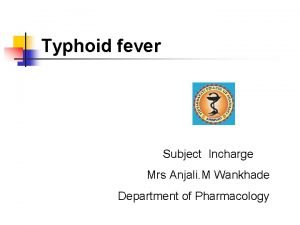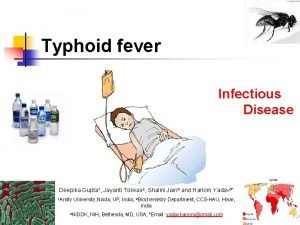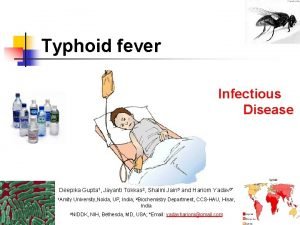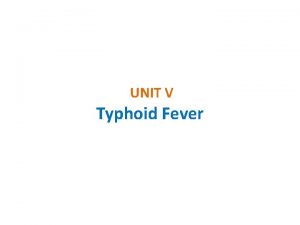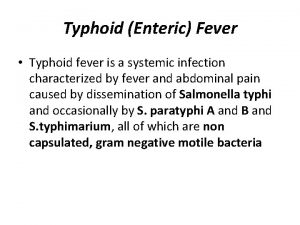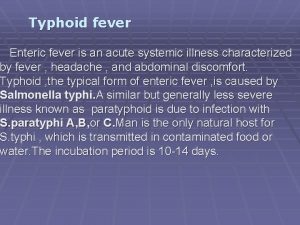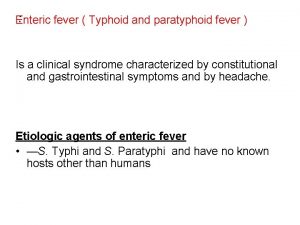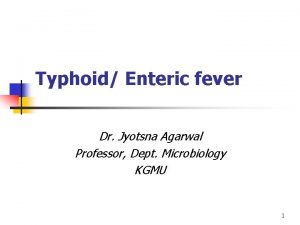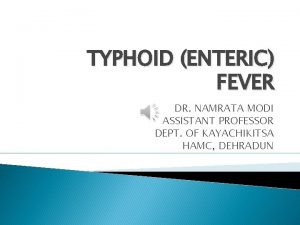Typhoid Enteric fever Digital Pathology Collection Case 8











- Slides: 11

Typhoid (Enteric fever) Digital Pathology Collection Case 8 2009 Ref. XVI: iii: 7 University of Cape Town

Clinical data • This patient died in 1931. • She was a 14 year old coloured girl. • Her illness began 18 days before admission and symptoms were generalised pains, vomiting, fever, delirium and melaena. • Her temperature fluctuated between high and subnormal. • Her pulse was relatively slow and weakened gradually before she died. University of Cape Town

• The specimen is the ileocaecal junction and a length of proximal ileum • This view is of the serosal surface appendix University of Cape Town

• This view is of the mucosal surface. • There are several obvious lesions, which are shaped like Peyer’s patches. • The organism, Salmonella typhi, accumulates in lymphoid tissue in Peyer’s patches and causes the patches to become inflamed and ulcerated. University of Cape Town

• Some of the patches are covered by pseudomembrane. • Others have sloughed their membrane, leaving an ulcer bed. • In this case, no ulcer has perforated. • Our patient instead had another important late complication, bleeding, which occurs as slough separates. University of Cape Town

Closer view of an ulcer with a slough (pseudomembrane) that has not yet separated. University of Cape Town

• This is a rare example of typhoid ulceration extending to the large bowel. (ref. XVI: iii: 9) • In the proximal colon there are numerous small ulcers up to 0. 5 cm in diameter. • The difference in appearance is due to the fact that in the large bowel the lymphoid tissue is arranged in small nodules and not in large patches. Distal ileum Proximal colon University of Cape Town

• S. typhi survives intracellularly in macrophages. • It is disseminated via the reticulo-endothelial system to other organs. • It commonly settles in the gall bladder and can cause cholecystitis. • There also systemic effects attributable to its endotoxin. University of Cape Town

• Some survivors of typhoid become asymptomatic carriers and shed the organism in their faeces. • Typhoid is spread by poor sanitation and poor hygiene. • The story of “Typhoid Mary” is instructive, see http: //en. wikipedia. org/wiki/Mary_Mallon University of Cape Town

Another example from the collection • This specimen shows the typical typhoid lesions in the terminal ileum (all have lost their slough). • Four members of the family contracted typhoid. The disease was fatal in this patient and one of her children. University of Cape Town

A selection of cases from the Digital Pathology Collection by the Department of Clinical Laboratory Sciences University of Cape Town is licensed under a Creative Commons Attribution-Non. Commercial-Share. Alike 2. 5 South Africa Licence The full Digital Pathology Collection is accessible at www. digitalpathology. uct. ac. za If you would like to use an image or other item from our site that is not labelled with the Creative Commons Licence Logo, please contact the curator for permission. University of Cape Town

